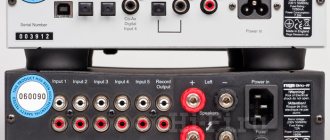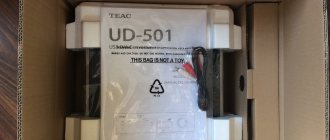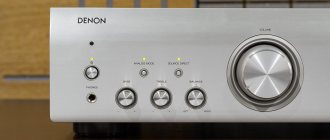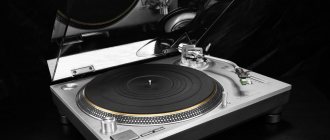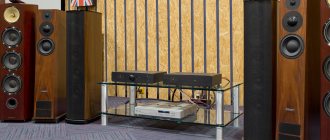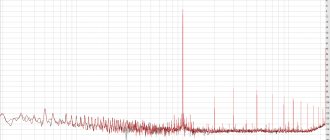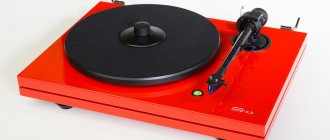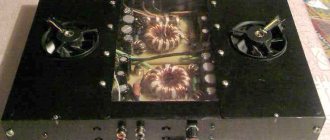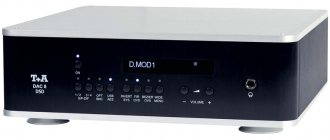Rega components: Apollo-R, DAC, Brio-R
Rega Apollo-R CD player, Rega DAC digital converter and Rega Brio-R integrated amplifier
Manufacturer: Rega Research Ltd (UK)
www.rega.co.uk
British Rega is an example of a commercially successful project implemented contrary to all market trends. When the entire hi-fi industry rushed to make CD players, Roy Gandy continued to improve vinyl turntables. When audiophiles became fascinated by the topic of DVD-Audio and SACD, Rega deigned to introduce its first digital component - the Planet CD player. Today, in the era of total transition to network audio, the company is again going against the grain.
Why is this “late ignition” always in favor of Rega?
The answer is simple - they know how to bring things to fruition here. A long time ago, when the specifications for the optical media Compact Disc Digital Audio (the so-called “red book” standard) were just being approved, electronics manufacturers did not yet have the necessary hardware to fully implement this format. For example, the channel decoding and mathematical data processing prescribed by the standard using the Reed-Solomon algorithm (reading error correction) in theory required the presence of a bank of RAM and a very powerful processor in the digital path. Of course, at that time no one was going to turn a household player into something like a computer - they made do with much more affordable and technologically advanced error correction solutions proposed by Sony and Philips, developers of the CD format. Year after year, digital logic was improved, but this continued exactly until the industry switched to a new direction - DVD.
But Rega engineers did not participate in the general race for bits, but began to improve the weakest link of the player - the path between the laser head and the DAC. The first device to implement proper digital readout control, correct error detection and correction using the precise Reed-Solomon algorithm was the Apollo player. To bring it to market, at the beginning of the 2000s, Rega entered into cooperation with one of the chipset developers and received the required 32-bit receiving processor with a 20-megabyte buffer. In addition, a special operating system that has no analogues was written for the player. The only “foreign” one was the top-loading Sanyo drive, which, however, also underwent modifications - the disk on the spindle of the new model was not pressed by a magnetic washer, but was fixed by three spring-loaded balls.
The company decided to support the success of the Apollo player (more than 20 thousand of them have been sold since 2005) with the new Apollo-R model, made in a fashionable “half” form factor. It differs from its predecessor not only in dimensions. The metal chassis seems to have become even stronger, despite the plastic front. Instead of the Wolfson WM8740 DAC, a more modern 8742 (also differential 24-bit) is used. The lid covering the tray with the disc is also designed differently - in the spirit of the top-end Rega Isis devices. The Apollo-R datasheet also talks about improvements to the analog output stage and power supply, but does not mention any technical details. However, they are not so important, because this player should not be considered separately, but primarily as part of the Rega system from the same compact components: the Brio-R integrated amplifier and the external Rega DAC converter, with which we have already introduced our readers*.
First, we connected the CD player analoguely directly to one of the Brio-R's line inputs. The result would probably surprise many music lovers - it rarely happens that two miniature components, working with large floor-standing acoustics, produce such an even tonal balance and extremely specific pattern. However, the strong absolute dynamics and pure, uncluttered microdynamics here are rather the merit of the integrated amplifier. As, indeed, the bass. It is not rude, without excessive impulsiveness, but bold and meaningful.
The combination sounds strong and beautiful; if any complaints can be made about it, then they are petty ones. There is a haze in the top band that gives the reproduction an artificial softness. The stage is slightly lacking in imagery: large virtual sources with a low spectrum swell slightly in space, and “point” high-frequency sources located on the flanks of the stage are attracted to the speaker tweeters. Although in general the space is well localized, three-dimensional and filled with “air”, and not hardware micronoise.
The believability of the middle register is also captivating. It is open and easy to understand. And such naturalness is definitely the merit of the player. Apollo's predecessor was also famous for its almost analogue “voice”. So the new model demonstrates the absence of digital tension in the sound, which distinguishes it from others.
The inclusion of a third component in the path - the Rega DAC converter - did not bring any radical changes (by the way, it uses the same WM8742 DAC). It feels like he plays according to all the Rega canons, except that he interprets the bass a little more thoroughly. But with this component new opportunities open up. The output amplifier-filter in the converter, made according to a differential circuit, according to the description, can change the depth of feedback and the slope of the frequency response cutoff at HF. And the button in the center of the Rega DAC, which is responsible for changing modes, sometimes begins to work small miracles.
In the first position, spatial images become more physical, large forms stand out better in a musical picture, and small ones, on the contrary, are weakened due to some simplification of the nuances. The second position is interesting because the sound becomes a little richer in harmonic terms and larger in space. The third filter position is the most melodious, and the fourth is the most dynamic. Choose: either ideal purity and tonal intelligibility, which will be very useful when listening to choral works, or a flow of drive without signs of sweetness and refinement, which will give the necessary courage to fatal things. There is also a fifth position - the most extreme in terms of visibility: powerful structural bass, bright mids, sparkling, even sometimes aggressive highs, which, however, does not prevent you from plunging into a musical trance...
All you need is patience. After all, at first there will be no difference between the listed modes at all. But as the components warm up, as the listener becomes mentally immersed in the sound that these three small components create, the differences will become more noticeable - and so on, until you begin to determine them blindly.
This is normal for equipment of this brand. You need to be saturated with its sound, drink it to the dregs in order to understand something. “Tasting” in small sips is useless - Rega does not reveal its taste that way.
COMPONENTS
- Speaker systems Monitor Audio Gold Reference 20 (RUB 80,000)
- Cables:
- — interconnect RCA Musical Wire Cadence Signature (RUB 24,000)
- — digital coaxial Audioquest VDM-3 (5000 RUR)
- — acoustic Legacy TL Speaker (RUB 29,000)
- — network Physics Style PW-Reference (38,000 rub.)
- Power supply distributor Supra LoRad MD-06-EU Mk II/LoRad CS-EU 1.5 (RUB 6200/4300)
MUSIC WE LISTENED TO
- 1. “NAIM Sampler” (supplement to the magazines “Salon AV” and “AvtoZvuk”, 2003)
- 2. Niacin, “Time Crunch” (Magnacarta, 2001)
- 3. Rage Agains The Machine (Sony Music/Epic, 1992)
- 4. Tom Waits, “Bad As Me” (Island Records, 2011)
- 5. Susanna Yoko Henkel, Thaikovsky Concerto for Violin and Orchestra (Acousence Records, 2010)
Frequency response of the Rega Brio-R phono stage
The amplifier's frequency response from linear inputs does not have the slightest deviation in the range of 10 Hz - 20 kHz, so it is not given here.
The phono stage characteristic from 20 to 30 Hz passes between the standard RIIA (green) and IEC (red) curves; at medium and high frequencies the frequency response fully complies with both standards.
Rega Apollo-R
Digital outputs: TOSLink and Coax p Analog outputs: Linear RCA p Distortion: 0.005% p Dimensions: 216 x 90 x 350 mm p Weight: 7 kg p Price: 47,940 rub.
Rega DAC
Digital inputs: USB, 2 TOSLink, 2 Coax p Digital outputs: TOSLink and Coax p Analog outputs: Linear RCA p Playback range (176.4, 192 kHz): 10 - 41000 Hz p With ripple: -0.05 dB (LF ), -1 dB (HF) p Distortion: 0.006% p Signal-to-noise ratio: 105 dB p Dimensions: 216 x 80 x 270 mm p Weight: 4 kg p Price: 30,900 rub.
Rega Brio-R
Inputs: Phono and 4 RCA p Outputs: RCA p Input impedance: 47 kOhm p Output power: into a load of 8 Ohms - 2 x 50 W, into a load of 4 Ohms - 2 x 73 W p Playback range: 12 - 43000 Hz p At unevenness: -1 dB (LF), -3 dB (HF) p Power consumption: 195 W p Dimensions: 216 x 80 x 340 mm p Weight: 8 kg p Price: 36,550 rub.
*Rega Brio-R was in the amplifier group test in No. 4/2012, and Rega DAC was in the USB-DAC group test in No. 5/2012
Dependence of SOI on output power of Rega Brio-R
Please note that the amplifier's distortion level does not depend on the output power up to 32 W at 8-ohm load and up to 65 at 4-ohm. Accordingly, the harmonic coefficient does not exceed 0.012 - 0.02% in the first case and 0.02 - 0.04% in the second.
In addition, when moving to a 4-ohm load, the output power doubles. Despite its compact size, this amplifier has a high power output, allowing it to work with any acoustics.
Harmonic spectrum of the Rega Brio-R amplifier
The measurements were carried out at 20 watts; at lower power, distortion could not be distinguished against the background noise. The SOI turned out to be 0.02%, and entirely due to the 2nd, 4th and 6th harmonics. The 2nd dominates, which can give the sound warmth and musicality, although for a push-pull amplifier such a ratio of even and odd components is atypical. The complete absence of high-frequency components promises transparency in the upper range, absence of hardness and coloration.
share
Tags: RegaStrong link
Rega Apollo review. Magazine "DVD Expert"
Rega products are a separate world with its own laws and principles. Its appearance is original and unchanged, and all models have their own names. Apollo is the successor to the Planet2000 player, but is noticeably different from its legendary ancestor.
Save and read later -
Rega Apollo
Advantages:
Excellent transmission of the rhythmic pattern of music, natural, embossed sound, support for compressed audio
Disadvantages:
Top loading of the disc is not very convenient, laser exposure when changing media
Apollo 1
While outwardly indistinguishable from Planet2000, Apollo is in fact completely unlike it. You can even see the difference with your own eyes. Opening the disk compartment, we find that the new transport has latches located directly on the spindle, while the previous model used a complex design with a clamping mechanism located in the cover. A different approach to installing the disk, according to the manufacturer, provided better dynamic performance of the drive and made it possible to avoid deformation of the media surface, which happened when using magnetic clamping. The servo drive that controls the position of the reading head was developed jointly with Rega specialists and is characterized by the highest accuracy of laser positioning and focusing. After such serious statements about the quality of its drive, the company openly says that even all this does not guarantee perfect reading, and therefore Rega Apollo has the most modern and efficient error correction system installed. For complete data processing, the circuit includes a 20 MB buffer memory, which allows you to obtain the time reserve required when digesting information received from problem disks. Thus, the error reading and correction device allows the player to play even seriously worn and scratched media without much difficulty. Well, the approach is peculiar and makes Apollo an even more controversial component. “First support for compressed audio, then reading defective discs... What's next?” - this is what a particularly doubtful connoisseur of high-quality sound might think. And then everything is more than solid and decent.
A high-precision clock generator, a special low-noise digital circuit implementation, a dual differential delta-sigma DAC customized by Rega by Wolfson, and, of course, a Class A output stage. Impressive? How could it be otherwise - after all, this is Rega...
Singing Apollo
Branded players have always been distinguished by original controls. Large rubber buttons with a low profile, literally decorating the facade of the device, have such an obvious purpose that no inscriptions under them are required. But it’s not easy to say the same about old-style remote controls. With those four buttons that control playback, everything was simple, but the rest was more confusing than helping to understand the controls. However, this is in the past. The new remote control looks more traditional, which is why it is understandable at first glance, and with a rather modest design and even more modest performance, it is very convenient and functional.
The ancient god Apollo, after whom the player is named, stood out among his colleagues for his rather passable singing abilities (although we personally find it difficult to judge this). In any case, the vocal numbers interpreted by Rega Apollo seem very interesting. The sound of the player is absolutely recognizable and is distinguished by excellent rhythm, naturalness and composure. The latter quality is taken literally to the limit, so that sometimes you begin to suspect the device that it eats up the aftersound a little in order to make the abrupt rhythms look as expressive as possible. Of course, this style makes itself felt in rock music, which is performed extremely brightly, articulately and energetically. The Chemical Brothers duo is welcomed by the player as if it were family and performs simply great. How could it be otherwise - fellow countrymen... By the way, since we touched on the origin of the component: the emotionality of Rega Apollo is also truly English - extremely restrained. The music is presented quite analytically, although the player does not bring it to the state of a dry set of sounds; Joe Cocker suddenly moves away from the image of a rollicking, seasoned ladies' man, puts on a tuxedo and chooses a downright academic style of performance. But the classics performed by Apollo sound quite adequate - decorous, noble, completely classical (not without reason, apparently, Apollo was a patron of the arts). By the way, an interesting and not entirely pleasant technical point was connected with the classics: the player did not allow us to enjoy Anna Netrebko’s singing, since it flatly refused to see the CD layer on the SACD hybrid disc. For those whose music library is as diverse as ours, we advise you to pay attention to this.
In conclusion, let us once again emphasize the characteristic features of Rega Apollo's signature sound - rhythmicity, articulation, naturalness and analytical accuracy. This sound is very interesting and quite unique.
Be careful, laser!
Top loading of the disc requires particularly conscious actions during the operation of the player. The main rule is not to touch the laser, which means from the first days you need to develop the habit of inserting and removing the disk in such a way that your fingers do not end up dangerously close to the read head. The process of installing/removing media is also very delicate - the latches are quite tight, but the force must be applied as evenly as possible so as not to damage the drive or the surface of the disk.
Prepared based on materials from DVD Expert magazine, September 2008
www.dvdexpert.ru This review was read 8,763 times
